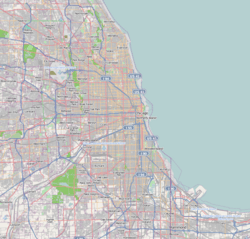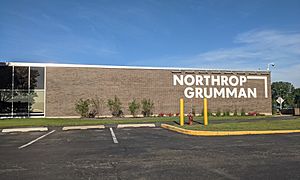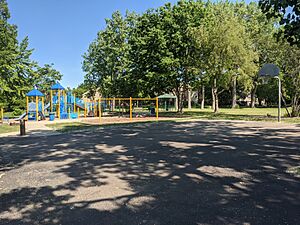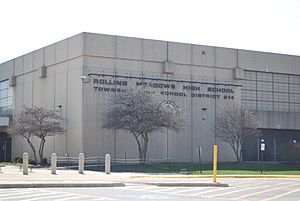Rolling Meadows, Illinois facts for kids
Quick facts for kids
Rolling Meadows, Illinois
|
|||||
|---|---|---|---|---|---|
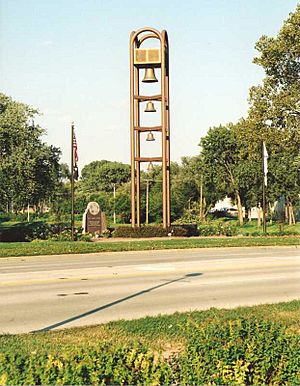
Bell tower in Rolling Meadows
|
|||||
|
|||||
| Motto(s):
"Progress Thru Participation"
|
|||||
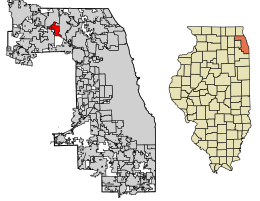
Location of Rolling Meadows in Cook County, Illinois.
|
|||||
| Country | |||||
| State | Illinois | ||||
| County | Cook | ||||
| Township | Palatine, Elk Grove, Wheeling | ||||
| Incorporated | 1955 | ||||
| Area | |||||
| • Total | 5.62 sq mi (14.56 km2) | ||||
| • Land | 5.62 sq mi (14.54 km2) | ||||
| • Water | 0.01 sq mi (0.02 km2) 0% | ||||
| Population
(2020)
|
|||||
| • Total | 24,200 | ||||
| • Density | 4,309.12/sq mi (1,663.81/km2) | ||||
| Standard of living (2009-11) | |||||
| • Per capita income | $29,099 | ||||
| • Median home value | $251,900 | ||||
| ZIP code(s) |
60008
|
||||
| Area code(s) | 847 and 224 | ||||
| FIPS code | 17-65338 | ||||
Rolling Meadows is a city in Cook County, Illinois, USA. It's a suburb of Chicago. In 2020, about 24,200 people lived there.
Contents
History of Rolling Meadows
Early Settlers and Farming
In 1836, Orrin Ford was the first person to own land here. He claimed 160 acres in an area called Plum Grove. Other farm families soon followed him. Many of them came from Vermont. By the early 1840s, settlers had built a dam. It was across Salt Creek. They had also claimed all of the Plum Grove area.
Growth and German Immigrants
In 1850, this community became part of Palatine Township. This happened as German immigrants moved into the area. In 1862, the Salem Evangelical Church was built. Its cemetery, which is 40 square feet, still exists today. You can find it at the corner of Kirchoff and Plum Grove roads.
Developing a New Community
In 1927, H.D. "Curly" Brown bought 1,000 acres of land. He planned to build a golf course and a racetrack. In the early 1950s, Kimball Hill bought the golf course land. He started selling homes by advertising in the Chicago Tribune.
People liked his house plans. But officials in nearby Arlington Heights didn't agree. They wanted to buy the land for large estate homes. However, future buyers of Kimball Hill's homes convinced the Cook County Board. They approved changes to allow Hill to build.
Founding the City
In 1953, the first families moved into the new homes. Kimball Hill named the development Rolling Meadows. By 1955, 700 houses were sold. Most buyers were blue-collar workers. Hill gave $200 per home to help start a school system. He also built and equipped the first elementary school.
He started the Rolling Meadows Homeowners' Association. He also gave land for parks. Hill also helped fund the Clearbrook Center. This center helps people with cognitive disabilities. It opened in 1955.
Modern Growth and Businesses
Rolling Meadows officially became a city in 1955. It soon started adding more land for growth. The city grew quickly in the 1950s and 1960s. Many businesses moved into the area.
Crawford's department store opened in 1957. It was the biggest in the northwest suburbs. It closed in 1994. An industrial park opened in 1958. Western Electric opened a facility in the 1960s. It employed 1,500 workers.
Many apartment buildings were built. By 1970, apartments made up 35 percent of all buildings. After several fires in apartment complexes, the city made building rules stricter. This was to make sure buildings were safer.
By 2000, the city began improving shopping areas. Along Golf Road, big companies like 3Com, Helene Curtis, and Charles Industries set up offices. This area is now known as the Golden Corridor.
Geography and Location
Rolling Meadows is located about 24 miles northwest of the Chicago Loop. The Chicago Loop is the main downtown area of Chicago.
In 2021, Rolling Meadows had a total area of 5.62 square miles. Almost all of this area (99.89%) is land. Only a very small part (0.11%) is water.
People of Rolling Meadows
| Historical population | |||
|---|---|---|---|
| Census | Pop. | %± | |
| 1960 | 10,879 | — | |
| 1970 | 19,178 | 76.3% | |
| 1980 | 20,167 | 5.2% | |
| 1990 | 22,591 | 12.0% | |
| 2000 | 24,604 | 8.9% | |
| 2010 | 24,099 | −2.1% | |
| 2020 | 24,200 | 0.4% | |
| U.S. Decennial Census 2010 2020 |
|||
Population and Households
As of the 2020 census, 24,200 people lived in Rolling Meadows. There were 8,491 households. A household is a group of people living in one home. There were also 6,013 families. The city had about 4,304 people per square mile.
There were 9,780 housing units. These are places where people can live. About 32.5% of households had children under 18. About 54.48% were married couples living together. The average household had 3.21 people.
Diversity in the City
The people in Rolling Meadows come from many backgrounds. Here's a look at the different groups in 2020:
- 59.48% White
- 2.80% African American
- 1.28% Native American
- 13.07% Asian
- 0.07% Pacific Islander
- 12.69% from other races
- 10.61% from two or more races
People who are Hispanic or Latino made up 25.26% of the population. They can be of any race.
Age and Income
The median age in the city was 38.0 years old. This means half the people were younger and half were older.
- 22.7% were under 18 years old.
- 15.3% were 65 years or older.
The median income for a household was $78,609. For a family, it was $91,197. The average income per person was $37,478. About 5.6% of the people lived below the poverty line.
| Race / Ethnicity (NH = Non-Hispanic) | Pop 2000 | Pop 2010 | Pop 2020 | % 2000 | % 2010 | % 2020 |
|---|---|---|---|---|---|---|
| White alone (NH) | 17,282 | 14,948 | 13,528 | 70.24% | 62.03% | 55.90% |
| Black or African American alone (NH) | 662 | 514 | 637 | 2.69% | 2.13% | 2.63% |
| Native American or Alaska Native alone (NH) | 28 | 8 | 8 | 0.11% | 0.03% | 0.03% |
| Asian alone (NH) | 1,623 | 1,961 | 3,147 | 6.60% | 8.14% | 13.00% |
| Pacific Islander alone (NH) | 7 | 6 | 13 | 0.03% | 0.02% | 0.05% |
| Other race alone (NH) | 27 | 28 | 60 | 0.11% | 0.12% | 0.25% |
| Mixed race or Multiracial (NH) | 250 | 300 | 694 | 1.02% | 1.24% | 2.87% |
| Hispanic or Latino (any race) | 4,725 | 6,334 | 6,113 | 19.20% | 26.28% | 25.26% |
| Total | 24,604 | 24,099 | 24,200 | 100.00% | 100.00% | 100.00% |
Economy and Jobs
Rolling Meadows is home to many businesses. The Chicago office for Huawei is located here. Asiana Airlines also has a sales office in the city.
Here are some of the top employers in Rolling Meadows as of 2018:
| # | Employer | # of employees |
|---|---|---|
| 1 | Northrop Defense Systems | 2,450 |
| 2 | Arthur J Gallagher | 2,000 |
| 3 | Verizon Wireless | 900 |
| 4 | Capital One | 800 |
| 5 | CareerBuilder Employment Screening | 450 |
| 6 | Komatsu | 300 |
| 7 | A.H. Management Group | 300 |
| 8 | RTC | 235 |
| 9 | Meijer | 230 |
| 10 | Walmart | 200 |
Parks and Recreation
The Rolling Meadows Park District started in 1958. It has been recognized four times for its excellent parks and recreation management.
The Salt Creek Rural Park District began in 1956. It offers fun activities and services. These are for people living in parts of Arlington Heights, Palatine, and Rolling Meadows. People from outside the area can also use the services for a fee.
Education in Rolling Meadows
Schools for All Ages
Most of Rolling Meadows is served by Palatine Community Consolidated School District 15. This district has several schools in Rolling Meadows:
- Central Road (Kindergarten to 6th grade)
- Kimball Hill (Kindergarten to 6th grade)
- Willow Bend (Kindergarten to 6th grade)
- John G. Conyers Learning Academy (for early childhood and special needs)
Students from these schools often go to Carl Sandburg Jr. High (7th-8th grade). Some students also attend Plum Grove Jr. High (7th-8th grade).
A small part of the city is served by Arlington Heights School District 25. Students there go to Westgate Elementary and South Middle School. Then they attend Rolling Meadows High School. Other small parts are served by Schaumburg Consolidated School District 54 and Community Consolidated School District 59.
High Schools
About half of Rolling Meadows students attend Township High School District 214's Rolling Meadows High School. The other half attend Township High School District 211's William Fremd High School in Palatine.
Catholic Schools
The Roman Catholic Archdiocese of Chicago used to operate St. Colette School. It was a Catholic school for pre-kindergarten to 8th grade. St. Colette School was recognized as a Blue Ribbon School in 2007. However, the school closed after Spring 2020.
Transportation
Pace provides bus services in Rolling Meadows. These buses connect the city to other places. You can travel to Des Plaines, Schaumburg, and more.
Notable People
Many interesting people have connections to Rolling Meadows:
- Bryan Anderson – An author and veteran of the Iraq War.
- Jay Bennett – A guitarist who played with the band Wilco.
- Gary Cole – A well-known film and television actor.
- Carol Marin – A journalist for television and newspapers.
- Tim McIlrath – The lead singer of the punk rock band Rise Against.
- Scott Tolzien – A former NFL quarterback for teams like the Indianapolis Colts.
- Jimmy Garoppolo – An NFL quarterback who played for the New England Patriots and San Francisco 49ers.
See also
 In Spanish: Rolling Meadows para niños
In Spanish: Rolling Meadows para niños





